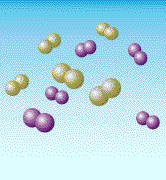Knocking the NOx Out of Coal
 Nitrogen is the most common part of the air we breathe. In fact, about 80% of the air is nitrogen. Normally, nitrogen atoms float around joined to each other like chemical couples. But when air is heated in a coal boiler's flame, for example these nitrogen atoms break apart and join with oxygen. This forms 'nitrogen oxides' or, as it is sometimes called, 'NOx'. NOx can also be formed from the atoms of nitrogen that are trapped inside coal. In the air, NOx is a pollutant. It can cause smog, the brown haze you sometimes see around big cities. It is also one of the pollutants that forms 'acid rain.' And it can help form something called 'groundlevel ozone,' another type of pollutant that can make the air dingy. NOx can be produced by any fuel that burns hot enough. Automobiles, for example, produce NOx when they burn gasoline. But a lot of NOx comes from coal-burning power plants, so the Clean Coal Technology Program developed new ways to reduce this pollutant.
Nitrogen is the most common part of the air we breathe. In fact, about 80% of the air is nitrogen. Normally, nitrogen atoms float around joined to each other like chemical couples. But when air is heated in a coal boiler's flame, for example these nitrogen atoms break apart and join with oxygen. This forms 'nitrogen oxides' or, as it is sometimes called, 'NOx'. NOx can also be formed from the atoms of nitrogen that are trapped inside coal. In the air, NOx is a pollutant. It can cause smog, the brown haze you sometimes see around big cities. It is also one of the pollutants that forms 'acid rain.' And it can help form something called 'groundlevel ozone,' another type of pollutant that can make the air dingy. NOx can be produced by any fuel that burns hot enough. Automobiles, for example, produce NOx when they burn gasoline. But a lot of NOx comes from coal-burning power plants, so the Clean Coal Technology Program developed new ways to reduce this pollutant.
One of the best ways to reduce NOx is to prevent it from forming in the first place. Scientists have found ways to burn coal (and other fuels) in burners where there is more fuel than air in the hottest combustion chambers. Under these conditions, most of the oxygen in air combines with the fuel, rather than with the nitrogen. The burning mixture is then sent into a second combustion chamber where a similar process is repeated until all the fuel is burned. ,This concept is called 'staged combustion' because coal is burned in stages. A new family of coal burners called 'low-NOx burners' has been developed using this way of burning coal. These burners can reduce the amount of NOx released into the air by more than half. Today, because of research and the Clean Coal Technology Program, more than half of all the large coal-burning boilers in the United States will be using these types of burners.
There is also a family of new technologies that work like 'scubbers' by cleaning NOx from the flue gases (the smoke) of coal burners. Some of these devices use special chemicals called 'catalysts' that break apart the NOx into non-polluting gases. Although these devices are more expensive than 'low-NOx burners,' they can remove up to 90 percent of NOx pollutants. But in the future, there may be an even cleaner way to burn coal in a power plant. Or maybe, there may be a way that doesn't burn the coal at all.
Fact Credit
NASA Aerospace Technology Enterprise


